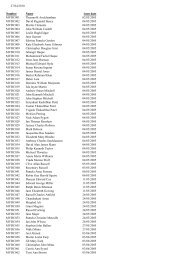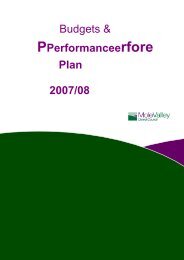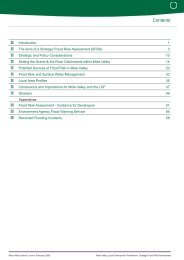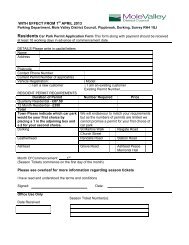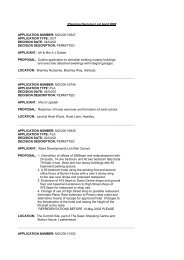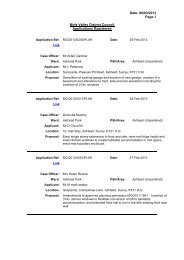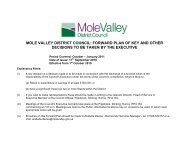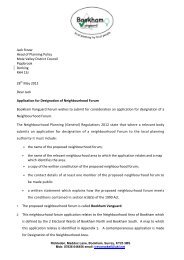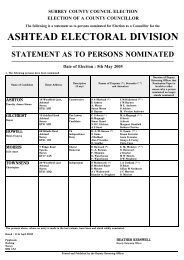MOLE VALLEY NATURAL HISTORY AUDIT BUTTERFLIES
MOLE VALLEY NATURAL HISTORY AUDIT BUTTERFLIES
MOLE VALLEY NATURAL HISTORY AUDIT BUTTERFLIES
You also want an ePaper? Increase the reach of your titles
YUMPU automatically turns print PDFs into web optimized ePapers that Google loves.
Mole Valley Agenda 21 - Nature Conservation Sub-Group ©<br />
<strong>MOLE</strong> <strong>VALLEY</strong> <strong>NATURAL</strong> <strong>HISTORY</strong> <strong>AUDIT</strong><br />
<strong>BUTTERFLIES</strong><br />
Compiled by Gail & Stephen Jeffcoate
Butterfly Indicator Species for Mole Valley<br />
Three butterfly species have been chosen as indicator species for Mole Valley. They are:<br />
Silver-spotted Skipper (Hesperia comma). This is a species of both local and national importance (It<br />
is a Red Data Book Species). One of the largest metapopulations in Britain exists along the North<br />
Downs between Gomshall in the west and Reigate in the east and most of the habitat patches within this<br />
population are in the Mole Valley area. The Silver-spotted Skipper is on the northern edge of its range<br />
in southern Britain and has a very limited distribution, with colonies in the Chilterns, South Downs,<br />
Wiltshire and Dorset in addition to the Surrey population. It needs higher temperatures in which to<br />
breed than any other British butterfly and can only survive on a short sparse sward on south facing<br />
slopes of chalk grassland. Adults are relatively mobile (up to about 5km) and have a high dispersal rate.<br />
As most suitable habitat patches in the area are less than 0.5 hectares in size this means that a number of<br />
such patches must remain in existence for the insect to survive. Loss or degeneration of habitat patches<br />
below a critical level would result in the loss of the entire Surrey population. NB rabbit populations are<br />
in some cases beneficial to the species as rabbit grazing keeps the sward in the right condition but<br />
current very high rabbit populations are in some places damaging the habitat by overgrazing. If<br />
significant changes in rabbit populations occur, monitoring of the effect on Silver-spotted Skipper<br />
colonies will be needed.<br />
Marbled White (Melanargia galathea). This is a grassland species requiring longer sward than the<br />
Silver-spotted Skipper. It has spread slowly along the downs and is now much more widespread than it<br />
was 50 years ago. In Surrey it occured only on chalk grassland up to 1995 but it now appears to be<br />
spreading to other types of grassland and in 1996 has been seen in the Holmwood - Newdigate area.<br />
Monitoring of any further spread will be of great interest.<br />
White Admiral (Ladoga camilla). A woodland species more tolerant of shady conditions than most<br />
butterfly species the White Admiral has spread through Surrey woods in the 20th Century. It will be a<br />
good candidate for monitoring in the 21st Century as populations may change in response to different<br />
methods of woodland management and/or to climatic changes.<br />
For each of these species a 1995 county distribution map is available on a 1km scale. A list of sites in<br />
Mole Valley has been drawn up for each. All three are easily identified in the field. Other local species<br />
which should be monitored in future are: Dingy Skipper, Grizzled Skipper, Green Hairstreak, Brown<br />
Hairstreak, Small Blue, Adonis Blue, Brown Argus, Chalkhill Blue, Purple Emperor, Dark Green<br />
Fritillary, Silver-washed Fritillary and Wall Brown. Current records are held by Gail Jeffcoate and<br />
Surrey Wildlife Trust.
Mole Valley Agenda 21, Nature Conservation Sub-Group<br />
<strong>MOLE</strong> <strong>VALLEY</strong> <strong>NATURAL</strong> <strong>HISTORY</strong> <strong>AUDIT</strong><br />
<strong>BUTTERFLIES</strong>: Distribution and Status 1995/6<br />
Species:<br />
Silver-spotted Skipper<br />
It is difficult to separate populations of this species, which inhabits a number of small patches of<br />
suitable habitat along the downs, with movement of adults between patches. The Mole Gap probably<br />
acts as a barrier which few individuals cross, with metapopulations on either side. The species is<br />
vulnerable to loss of habitat; these losses may not be detected without careful monitoring by experts<br />
familiar with the requirements of the butterfly, but if available habitat were to fall below a critical level<br />
the entire metapopulation could die out very rapidly.<br />
Codes indicate maximum numbers seen on a single visit: A=1, B=2-9, C=10-29, D=30-99, E=100+.<br />
In 1995/6 the species was breeding in the following places:<br />
Population to west in Guildford Borough at Hackhurst and Colekitchen.<br />
White Downs area. National Trust. (Includes Blatchford Down TQ103487, Old Simms Field<br />
TQ105486, Old Plantation TQ107486, Chalk Quarry to east of road TQ114486, Great Down<br />
TQ117488, Chalkpit Field TQ119489, Wholecombe TQ123492, Lamb Leys TQ124495, Ranges<br />
TQ126495).<br />
Numbers up to C per visit. Currently very heavy rabbit grazing is rendering much Festuca ovina<br />
unsuitable even for this short turf specialist and there is potential for increases if rabbit numbers<br />
decrease, for instance due to Viral Haemorrhagic Disease.<br />
Denbies Hillside National Trust. Small populations in the Big Field TQ135500 (B-C), odd individuals<br />
seen in the Brow TQ146502 and Secretary's Field TQ149502.<br />
Box Hill National Trust. strong populations (C-D) on all grassland areas on north side of Hill, where<br />
Festuca sward is common. Smaller populations (A-B) on Viewpoint slopes and Dukes on the south side,<br />
where there is less Festuca currently in suitable condition.<br />
Mickleham Downs National Trust. TQ180535. Small population (B).<br />
Headley Warren TQ190538 (Private). Medium-sized population in Downs Field (C).<br />
Headley Heath, Chalk Slope area National Trust. TQ195533. Small population in South Paddock and<br />
on Terraces (B).<br />
Brockham Warren TQ198512. SCC. Good population (C) on old chalk workings.<br />
Betchworth Quarry TQ205155 Privately owned landfill area. Unsurveyed population on small<br />
patches of grassland, some inaccessible.<br />
Dawcombe Nature Reserve TQ215525. Currently owned by Smith Kline Beecham and managed by<br />
Surrey Wildlife Trust. Medium population (C) breeding mainly in the two compartments (known as A<br />
and B) at the north end of the reserve.<br />
Buckland Hills TQ228525-TQ233523. Privately owned by Buckland Estates. Population currently low<br />
due to excessive rabbit grazing in parts, and threatened in parts due to scrub/tree growth. Most<br />
threatened part of the Surrey SSS population.<br />
Juniper Hill TQ237520. NT. Population currently low due to excessive rabbit grazing.<br />
Mole Place TQ237522. Small area private land above Juniper Hill. Small pop. (B).<br />
Further population on Colley Hill to East, in Reigate & Banstead Borough.
Mole Valley Agenda 21, Nature Conservation Sub-Group<br />
<strong>MOLE</strong> <strong>VALLEY</strong> <strong>NATURAL</strong> <strong>HISTORY</strong> <strong>AUDIT</strong><br />
<strong>BUTTERFLIES</strong>: Distribution and Status 1995/6<br />
Species:<br />
Marbled White<br />
Codes indicate maximum numbers seen on a single visit: A=1, B=2-9, C=10-29, D=30-99, E=100+.<br />
White Downs. National Trust. Areas as for Silver-spotted Skipper. Numbers currently low due to<br />
excessive rabbit grazing, with A, B or C seen per visit. Numbers likely to increase if lower rabbit<br />
populations lead to taller sward.<br />
Denbies Hillside. National Trust. Found on all the grass compartments. Sward currently undergoing<br />
changes due to scrub removal, pony grazing, fluctuating rabbit populations. Marbled White populations<br />
generally strong with C or D seen per visit to most compartments. Higher numbers (E) may be seen in<br />
Steers Field, adjoining NT Car Park at TQ142503<br />
Box Hill National Trust. Can be found on all grass compartments. Strong populations on south slopes<br />
(Viewpoint slopes, Dukes) with D or E per visit on each. Lower numbers on the northern areas.<br />
Mickleham Downs TQ180535. National Trust. (C) -on grassland at top of slope.<br />
Cherkley Wood TQ187542, TQ 183547. Private. (C).<br />
Headley Warren TQ190538. Private. Up to C per compartment at present. The main grassland areas<br />
are currently very heavily rabbit grazed and Marbled White numbers can be expected to rise if sward<br />
height increases.<br />
Headley Heath, Chalk Slope Area National Trust. TQ195533. Small population. (B).<br />
Brockham Warren. SCC. TQ198512. Small population. Most grass too short. (A/B).<br />
Dawcombe Nature Reserve. TQ215525. Has become established in last 2-3 years, with numbers seen<br />
rising each year. In 1996 up to 20-30 seen per visit over whole site.<br />
Mole Place Private. TQ237522. Marbled White not seen here until 1995 (B). By 1996 well established<br />
(30 seen on one visit).<br />
Claypit on south side of Inholms Lane, North Holmwood. TQ175473. B seen 1996.<br />
The Marbled White has not been recorded from the Betchworth Quarry or Buckland Hills areas in<br />
1995/6, but is probably present in low numbers, and could increase if rabbit levels decrease.<br />
Single specimens seen in 1995/6 at: Polesden Lacey (NT) TQ182522; Hammonds Copse (field<br />
adjoining woodland) TQ 213442; on rough ground on north side of Trig Street, west of Newdigate,<br />
TQ190418
Mole Valley Agenda 21, Nature Conservation Sub-Group<br />
<strong>MOLE</strong> <strong>VALLEY</strong> <strong>NATURAL</strong> <strong>HISTORY</strong> <strong>AUDIT</strong><br />
<strong>BUTTERFLIES</strong>: Distribution and Status 1995/6<br />
Species:<br />
White Admiral<br />
Codes indicate maximum numbers seen on a single visit: A=1, B=2-9, C=10-29, D=30-99, E=100+.<br />
Bookham Common TQ125165. National Trust. Strong population (C).<br />
Somersbury Wood TQ108378 Ownership not known. Strong population (D).<br />
Holmwood Common TQ180460. National Trust. Patchily dispersed, most often seen in area to north<br />
of Fourt Wents Pond. (B).<br />
Hammonds Copse TQ213445. Woodland Trust. (C).<br />
Edolphs Copse TQ2242. Woodland Trust. (B).<br />
Glovers Wood TQ228408. Woodland Trust (B).<br />
Wallis Wood TQ122388. Surrey Wildlife Trust reserve. (B).<br />
Vann Lake TQ157394. Surrey Wildlife Trust reserve. (B).<br />
Ashtead Common/Epsom Common border TQ185600 Corporation of London, SCC. (B).<br />
Ashtead Common - Occasional sightings in other areas of Common.<br />
Princes Coverts TQ160610. Crown Estate. (B).<br />
Box Hill. National Trust. Occasionally seen in wooded areas, eg Juniper Bottom (TQ180527), single<br />
sighting 1996.<br />
Mynthurst, Leigh TQ224456. Privately owned woodland. (B).<br />
Little Gaterounds, Newdigate TQ195428. Privately owned woodland. (B).<br />
Occasional single sightings from other locations:<br />
Birchy Copse, TQ188413, between Capel, Newdigate. Jordans, TQ207386 &206394, near Sussex<br />
border north of Rusper. Oakwood Hill Churchyard TQ128380, near Walliswood. Broadmoor<br />
TQ134455.




